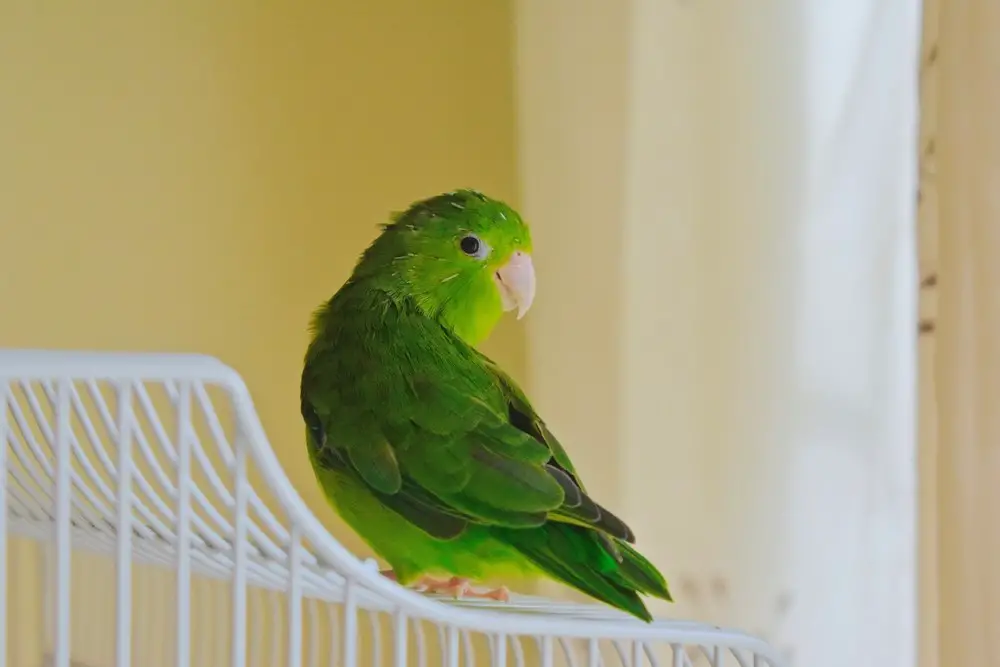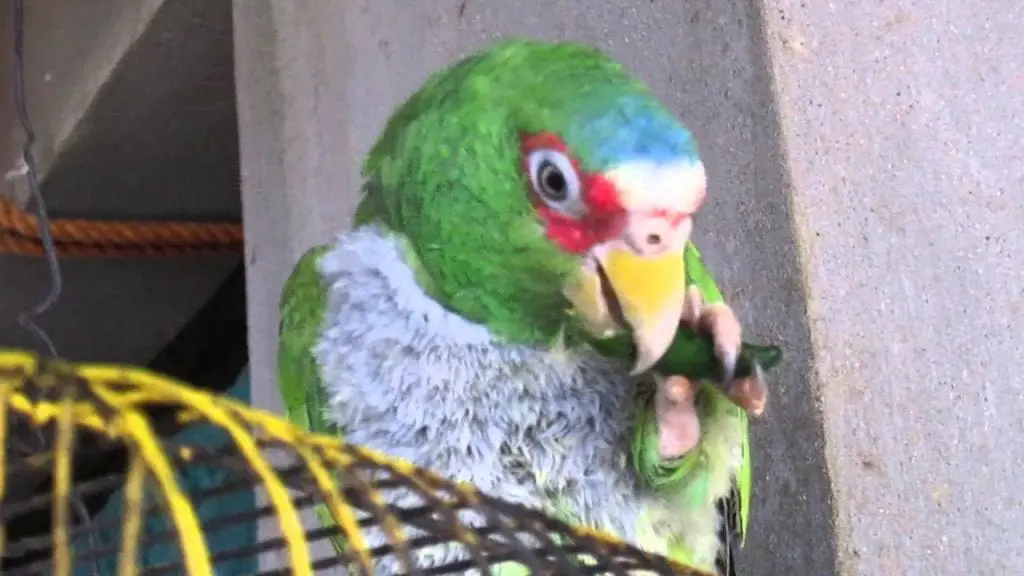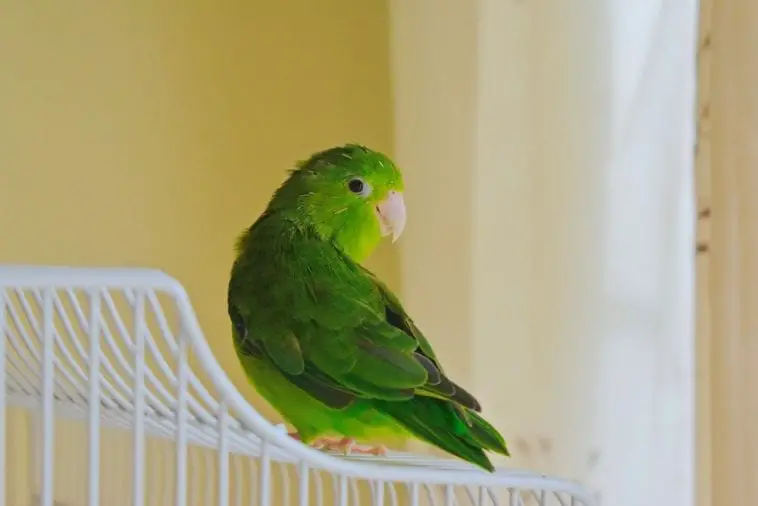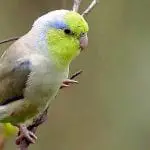Scientific Facts
| Common Name: | Mexican Parrotlet |
| Scientific Name: | Forpus Cyanopygius |
| Life Span: | 25 years |
| Size: | 13 cm |
| Habitat: | Subtropical or tropical scrublands |
| Country of Origin: | Mexico |

Physical Description
These little creatures are the exact description of “pocket-sized bird.” With adult Mexican parrotlets obtaining an average length of only 13 centimeters and weighing around 30 grams, there is no doubt that this bird is included in the list of smallest parrots. Its size can resolve the probable concerns involving free space because even a confined apartment can cater enough space for its flight. However, bear in mind that whatever they miss in size, they can compensate for their personality.
These small birds seldom exhibit bizarre colors or a lot of specifics. They are completely green. This slightly restrained green shade is darker on the wings and back and a bit lighter in the belly and on the face. Some rump feathers and wingtips are colored with turquoise. Even though this tint is plain, it still fits these birds best since it highlights their little frame and fits well with their appearances. Plenty of specifics on a cute bird can be astounding.
Male Mexican parrotlets have mostly green feathers. Its forehead, as well as the sides of the heads, including the abdomen and breast, are yellowish-green but paler. At times, a hint of mild bluish color is noticed in the abdomen. The shoulder feathers, under wing-coverts, and upper tail feathers are turquoise blue. The feathers, both the primary and secondary, including the greater wing-coverts, are colored with pale blue. The flight feathers and the base of the tail are bluish-green. They have faded horn-colored bill with a grey hint. Their eye rings are narrow, light grey. The feet are grey, and the irises are dark brown.
Females, on the other hand, are easily determined since they do not have the blue designations which are visible in males. The portions that are colored with blue in males are colored with yellowish-green in females. The lower portions are dazzling yellow shade, without blue dissemination seen either. The flight feathers and the lower side of the tail have no blue markings too. The feathers on the abdomen and breast are more yellowish.
Juveniles look similar to adults, although they are less dazzlingly colored. The blue designations in young males are combined with green.
Lifespan
Mexican parrotlets have an average lifespan of 25 years, although the life expectancy of these creatures may vary based on their current health conditions. If the birds are well-cared and are given a healthy and balanced diet, then there is a big chance for them to reach a longer lifespan.
Eating Habits
These birds are particular with their diet. They do not easily eat foods that are not commonly included in their diet. If the owner would alter their diet, the owner should allow the bird to adjust first. Owners cannot force these birds to eat new and unfamiliar foods. They would rather starve themselves than eat them. Nevertheless, owners may give the birds to adjust with the new diet until the bird recognizes that it is a safe food to eat.
Commonly, Mexican parrotlets eat fresh vegetables and fruits. Although what is commonly recommended are pellets because they contain the necessary nutrients and vitamins.

Sleeping Habits
Mexican parrotlets need at least 10 hours of sleep. A dark and quiet environment is always conducive for their sleeping because it makes them feel relax and comfortable. If you happen to place your pet inside your room, you must remember that having a television inside the room will not be helpful to your pet because of the noise and the corresponding light it gives.
Development and Reproduction
Mexican parrotlets commonly breed between May and July. The clutch size is averagely 3 eggs, which are commonly incubated for 19 days. The fledging period of the chicks consumes 4 to 5 weeks after the hatching.

How to Breed
Determining the Sexes
Mexican parrotlets demonstrate sexual dimorphism. Male parrotlets possess light turquoise feathers near the fronting edges of the wings and in their rumps, as well as the primaries, secondaries, and coverts. The females are fully yellow-green and a bit paler.
Some males have turquoise feathers around their heads and behind their eyes.
Courtship and Mating
Mexican parrotlets can immerse themselves in recreational mating, and they do not always mind which gender they are interacting with.
Eggs and Incubation
The typical clutch size is around 6 to 8 eggs, which are laid alternately. The mother birds will brood alone and commonly begin incubating the eggs once the second egg has been laid. The period of incubation takes around 19 days. During the incubation period, the mother seldom abandons the nest while the male feeds her. Also, during their period, the mother is susceptible to tremors and nest box inspection. The mother may choose to leave the eggs or chicks if she is disturbed.
The period of fledging normally lasts for 4 to 5 weeks. The young ones are continuously fed within 3 to 4 weeks, even after leaving the nest. It is essential to immediately take out the young ones if the parents begin breeding again because the chicks are sometimes harmed by the parents eager to breed again.
Common Health Problems
Parrot Fever
Parrot fever is an infectious disease that can occur in many bird species. It is commonly transmitted through bird specks of dust and contact with droppings. The indications for parrot fever include loss of appetite, discharges from nose and eyes, depression, difficulty in breathing, and watery, green droppings. It is important to immediately treat this kind of condition because it can lead to the death of the bird if it is left untreated. The best thing to do is to bring your pet to your trusted vet.
Giardia
Giardia is a parasitic disease. A dirty supply of water is the common reason for this illness. If you notice the pet to experience diarrhea, depression, weight loss, dry itching skin, and bulky tools, there is a big chance that your pet is getting this illness. This illness can be treated by antibiotics and normally needs numerous courses because of reoccurring. Giardia can be prevented by keeping clean and dry aviary and inhibiting overcrowding. It would be best to use water bottles rather than open water.
Infectious Diseases
Infectious diseases that suddenly occur in Mexican parrotlets are commonly caused by malnutrition or environmental issues, which heighten the vulnerability of the bird to disease organisms that are always available in its surroundings. This involves intestinal yeast and oral infection, liver and kidney disease, and skin infections. These problems cannot be treated even with the administration of antibiotics unless the fundamental cause is fixed. Of course, it is always recommended to consult your veterinarian in case you notice illness in your pet.
Malnutrition
Any common indications of illness can be an output of malnutrition. If the pet is given a balanced diet of nutritional pellets and fresh fruits and vegetables, this should not be an issue to worry about. Nevertheless, they may not have the essential vitamins necessary for their health. One should know the supplement guides to make sure his pet will conquer these deficiencies. Some indications of malnutrition are darkened feathers and feather stress bars.
Preventing Illnesses
If you apply good care and sufficient attention to your Mexican parrotlets, these birds can live far from illnesses and obtain a longer lifespan. Establish excellent settings in your area, abundant exercise and social synergy, and the most-important baths. One has to be careful when altering the diet of his pet. Some birds do not take new food and would rather get starve rather than eat a portion of unfamiliar food. Give your pet some time to adjust to the new diet.
Behavior
What makes the Mexican parrotlets so lovable and adorable is their amusing characteristics. They can easily capture your affection with their giddy tricks, nutty presence, and dynamic style. Another impressive aspect of Mexican parrotlets is their cute side. These birds can get very warm to their owners cuddle up to them in a probe for some warm, free time and scratches.
Mexican parrotlets create natural and exquisite sounding calls, including tweets, chirps, and a random blaring beep to signify their happiness. This is one of the reasons why they make good pets at home. These are social birds. Thus, if you conclude to get a pair or even more, you may look forward to some exclamations between them – with that, you should expect a bit more noise.
Mexican parrotlets are easy to get along with. They are comparably persistent, so you can coach them with a similar approach done to bigger birds. Always coach them the “up” trick, and take them out from the cage using this trick every time. During this time that they are placed outside the cage, the owner should closely supervise the pet. These birds are commonly detected because of their delighted squealing and twittering calls. They can be hard to see when touched down, considering their cute size and leaf-like look.
Habitat
Enclosure
Mexican parrotlets are dynamic little birds and demand huge flights to achieve good health and happiness. You must give them good-sized cages with the ideal dimensions. The cage should be a powder-covered metal and should measure at least 24 x 18 x 24 inches in height. Ensure that there is appropriate spacing between the bars. The gaps should be sufficiently small to prevent the bird from escaping. Bar spacing is ideally half an inch. There should be horizontal bars for the birds to climb. It would be great if you can have a grating on the base of the cage that isolates them from the flooring of the cage. The Mexican parrotlets need three isolated bowls for the freshwater, dry food, and another one for the fruit and vegetable.
If you are searching for a breeding place, then consider getting a huge, walk-in, well-built aviary with plenty of nest boxes than pairs and a lot of perches.
Toys and Perches
Install swings and plenty of toys since these birds are very energetic. Put some perches inside the cage. Remember to use bird-safe woods for the perches. You must train the Mexican parrotlet to step-up on the handheld perch. Although these birds are characterized to be gentle and have a sensitive trait, the truth is that this bird can become over-protective and territorial of the cage.
Diet
Mexican parrotlets originate from a dryer, less lavish, and less humid habitat; however, this species still need a nutrient-abundant, varied and balanced diet, and they cannot be anticipated to keep going on seeds alone.
Many pet stores today have stocks of commercial seed mixes, which were particularly developed for parrotlets. This should be the primary choice for founding a basic diet for the Mexican parrotlet. Next is to complement it with essential nutrients and vitamins, which are obtained from fresh vegetables and fruits. Seeds in good quality, such as canary seed, sunflower, weed seeds, oats, wheat, and various millets, are great for the bird. Various fresh vegetables and fruits such as carrots, green food, rose-hips, and apples must be offered regularly. This shall comprise an ideal diet for the bird.
Another great addition is the cuttlebone. Cuttlebone serves several functions – it is a potential source of calcium and a toy. But what is important is you never feed your bird with chocolate or avocado because these can harm your pet.
How to Care for Mexican Parrotlet
Mexican parrotlets are comparably quiet. They are bashful, specifically during the process of acclimatization. It is best to inhibit tremors and secure bushes in outside flights as covering places to evade strolling cast or upheavals at night-time to create a commotion among them, which may lead to wound and trauma as they bump the flight while attempting to go away. The process of acclimatization can be confronting. These pets are initially vulnerable to infections and cold. They cannot indulge well with abrupt changes in diet, and it is necessary to carefully and slowly recommend new food.
These birds love bathing so much, hence it is advised to regularly secure a shallow dish for bathing. To appease their longing for entertainment and chewing, give them fresh willow twigs.
Where to Get One?
You can get Mexican parrotlets in pet stores or breeders. However, make sure to get your new parrotlet from a trusted seller. You would not want to bring home sickly parrotlet. One way to determine a credible seller is their knowledge about the animal, particularly their diet and habitat.
FAQs
Is there anything I should avoid feeding on my Mexican parrotlet?
Yes. You should never feed your pet with chocolate and avocado. These are known foods that are harmful to your pet.
Is it ideal for a beginner like me?
Mexican parrotlets are easy to handle. Although they may have to undergo some adjustment period, it does not mean that it will be hard for a beginner to raise Mexican parrotlet. If you have the patience to bond with your new pet and you provide it with the essential things, then you are likely to become a good owner eventually.
How do I make them happy?
Remember that your pet is smart and very energetic. You can make them feel happy by simply bonding with him. You should also provide your pet with plenty of toys so they won’t get bored. These birds love to chew; hence, it will be very enjoyable for them if they are given chew toys.
Is my apartment suitable for my parrotlet?
Yes. Mexican parrotlet does not require a large space. As long as the environment is dry and clean, your new pet will be fine. You do not have to worry about your comfort at home. This bird is a quiet one, so you won’t be bothered with noises, especially when you are resting or sleeping.
What are the things to check when buying Mexican parrotlet?
The first thing to consider when buying Mexican parrotlet is its health condition. Check for any indication of illness. If you see any hints of health problems, then consider going to another seller.



